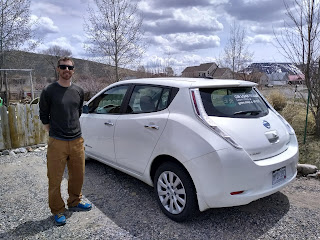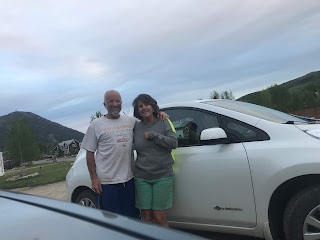ALLIY’S
EV JOURNAL:
Thursday,
October 11th 2018
Today’s
travels took me up to the Crested Butte office, to pick up the Leaf and bring
it back down to Gunnison for a member to borrow. I was a little nervous driving around in the
snow, not knowing how the EV would handle, but it took me where I needed to go
without any issues. It got me thinking
about whether there are any differences in winter care between EVs and vehicles
with combustion engines and if EVs need special treatment in the winter. Come to find out, they DO! Here are some tips and tricks to prolong your
EV battery in the winter, while staying comfortable during your drive.
1.
PRECONDITION YOUR BATTERY!
This is the single most recommended thing you should do.
If your car offers the option of setting a time to depart and warming up the
battery while it's still plugged in (and most of them do), use it!
Remember, a cold battery is not nearly as efficient as a warm
one. Some models even go the extra step and warm up the cabin while plugged in
as well.
By not using battery energy, this can increase your initial
range in cold weather by 15 percent to 20 percent. It's well worth it. .
2.
USE THE ECO MODE SETTING
Like preconditioning, this is a must for winter driving. Most
electric cars have an Eco or lower energy-usage drive setting.
The Eco mode may make your car feel slower, but it is there for
a reason: it boosts range by making your electric car operate more efficiently.
Eco mode also reduces the power output of the electric motor,
which can help traction in snow and ice, just like starting out in third gear
in a conventional car.
3.
BUNDLE UP
Another very effective form of range enhancement is to bundle
up: keep your coat on, and wear a hat, scarf and gloves.
Yes, this is different from the warm cabin you can have within a
few minutes in a gasoline car.
That comes from a small portion of the 75 percent of the
gasoline energy that's wasted in heat and noise by a combustion engine that
operates at just 25-percent efficiency.
In other words, its enormous waste of energy is keeping you
warm.
Don’t worry if you think you look like a dork; the real dork is
the guy stranded on the side of the road because he ran out of juice.
4.
USE SEAT HEATERS and
STEERING WHEEL HEATERS
Just use them, they don’t use that much juice.
It turns out, based on a couple of studies, that passengers
whose backs and backsides are warm feel like the car is much warmer than it
actually is.
The same applies to warm fingers if you have a steering-wheel
heater as well.
5.
STAY AT 65 mph or LESS
Any car uses more energy at highway speeds, because aerodynamic
drag increases exponentially with speed. Above 30 or 35 mph, it uses more
energy to push the wind aside than it does to move 2 tons of metal.
In freezing temperatures, your batteries are less efficient, so
they have to work harder to maintain highway speeds: it is a range suck.
Your car is also ingesting cold air and passing it over your
batteries at a much faster rate.
Keep your speed under 65 mph and, when you can, avoid the
highway altogether.
Similarly, chill out, no pun intended, when driving.
Think twice about passing the car in front of you or beating
that other guy off the line. Electric cars are exceptionally good for that, of
course.
It might be fun but you just cost yourself range and its worse
because your battery must work harder in the cold.
Stay with the flow of traffic, look ahead to see if you need to
gradually accelerate for an incline. Keep your momentum and watch your
power usage gauge.
6. USE THE SUN
I don't mean solar panels for charging, although obviously those
are a very good thing too.
But try to park out in the sun to warm up your batteries as well
as the interior.
I can’t stress enough on how well this actually works,
especially if your electric car will be sitting outside for a while—during your
workday, for example.
7. CYCLE MAX DEFROST ON and OFF
Windows can fog up in cold weather, so you will need to use the
defrosters, front and rear. For the windshield, I turn on max defrost
when I need it.
Depending on your electric car, defrosters can uses battery capacity
even faster than the standard heat, but they'll quickly and effectively clear
your windshield.
Once that's done, turn it off. And the same applies to the rear
defroster.
Over time, I've found that this technique actually helped me
squeeze out 5 to 10 more miles overall.
8. USE THE HEATER, AT A LOW LEVEL
Yes, resistance heating uses precious battery capacity. But, not using it during winter will lose you
passengers for certain, not to mention creating such a disincentive you won't
want to drive your electric car no matter how bundled up you may be.
Many electric-car owners don't know that turning on the heat
after it's been off for a long time uses more energy, because it must work
harder to heat up the cabin.
I keep my heater on, set to 70 degrees, and I raise the fan
speed a notch at a time if I need a little more.
This way the car, after preconditioning the interior, won’t need
to work as hard to keep cabin temp at a human level.
9. REGEN WHEN YOU CAN
Regenerative braking slows down the car without using friction
brakes, which are a total waste of energy that turns into heat and is
dissipated into the atmosphere.
More importantly, regeneration also puts energy back into the
battery. In winter, that's even more important.
Proper use of the car's regen can extend the car's range 10
percent to 15 percent.
On long downhill runs while the car is slowly recharging, I’ll
turn the heat up to take advantage of the juice being put back into the
battery. (It may take a little practice, but once you have it down it
becomes second nature.)
10. PLUG IN WHEN YOU CAN
Charging not only gives you miles back but warms the battery.
Even a trickle charge on a standard 12o-volt outlet is useful, especially if
you are there for a few hours.
Level 2 charging at 240 volts will give your battery even more
warmth, while a DC Fast Charge (DCFC) will make it nice and toasty. Even
just 15 minutes on a DC fast charger helps.
A warmer battery is a happier battery—and, don’t forget, while
the car is plugged in you can also precondition the cabin.
Note that charging takes more time with a cold battery. The
30-minute quick charge were counting on to give you an 80-percent boost might
only give you 50 percent. Make sure you plan for that.
11. CLEAN OFF YOUR CAR
One more thing, keep your car as clean of ice, slush and road
debris as possible. It adds weight and hurts the aerodynamics, which matter if
you do a lot of highway miles.
12. HOW ABOUT DRIVING IN SNOW
and ICE?
I find electric cars in these types of conditions are very good,
assuming you don’t have summer tires on (I strongly recommend winter tires!)
and you are careful.
I made it through some very tough winters with all-season tires,
and all but one of my electric cars has been rear-wheel drive.
As mentioned earlier, like any driver, you need to slow down and
plan ahead. Use the car's Eco mode to reduce off the line
acceleration.
Remember the drive is more direct, because EVs don't have
transmissions or revving engines that can produce a rubber-band effect on snow.
All of these techniques will help electric-car drivers gain back
or hold the line on lost range in cold weather.
Sure, you can garage your car in a heated garage, but once it
goes outside it won’t take long for it to feel the effects of the cold.
Note also that if you leave your car outside and unplugged
during a full workday, without any sun and in frigid temperatures, your battery
will be ice cold—and it may have used some of its energy to keep itself at a
sustainable temperature.
That means that its power delivery will also be down, possibly
way down as shown by missing power bars on your energy gauge. Don’t be alarmed!
That is the car protecting itself.
Once it's warmed up, those power bars will return and its
acceleration will feel more normal. The best thing you can do is be aware that
it may happen, bundle up, know where your public charging sites are ...
and, in extremis, text home to have some hot chocolate
waiting.
SOURCE: “Driving electric cars in winter: tips from experienced owner” by John Voelcker https://www.greencarreports.com/news/1109449_driving-electric-cars-in-winter-tips-from-experienced-owner





Comments
Post a Comment